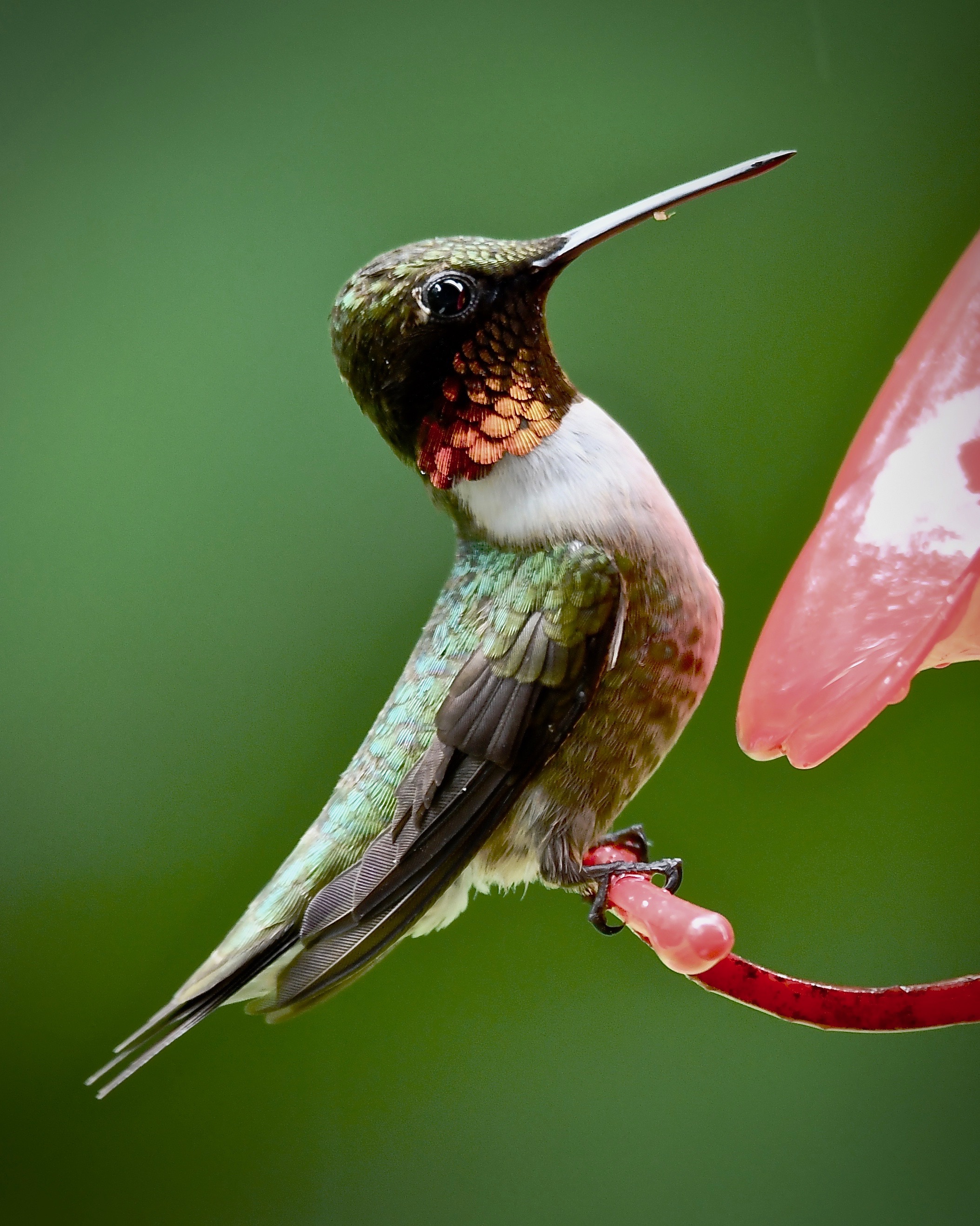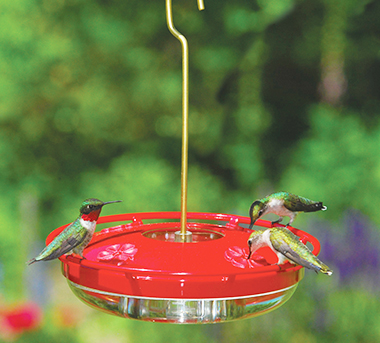Soon hummingbirds will ramp up their interest in feeders and the action will be fast and furious. August through mid-September is peak time for us to see hummingbirds at feeders. Based on frequently asked questions at the store there's a lot of confusion surrounding Ruby-throated hummingbirds and the first few months they are here. It is true Ruby-throated hummingbirds begin migrating through and into TN as early as mid-March. This year the first reported sighting by a customer was March 30. My first sighting was April 6th. By the way, I've recorded first of spring (FOS) hummingbird sightings for over 20 years and it's always between April 3 and April 12. And the first has always been an adult male.
Occasionally we here a customer say "I have all kinds of different hummingbirds" when in fact they really only have one kind, the Ruby-throated hummingbird. Only the adult male has the bright red throat while both sexes have an iridescent green back. Adult females and juvenile's look very much alike but will vary somewhat in plumage.
Although all Tennessee summer resident hummingbirds are here by mid-May, most people will see very little of them, and activity at feeders will be infrequent and minimal until at least early to mid-July when there is a sudden surge.
It is thought by many the reason for this sudden surge is they have just "come back" from where they've been. Actually, it is that the summer resident hummingbirds have concluded raising one or even two broods of offspring and are ready to begin taking advantage of the free nectar in the feeders you've provided. Also, the added activity is indicative of recently fledged hummingbirds beginning to understand and visit feeders. Then as we move into August hummingbirds that have been north of us, as far as Canada, will begin their migration south and stop at feeders along the way.
It must be remembered hummingbirds don't travel all the way from central and south America because there are hummingbird feeders here. They DO NOT NEED the feeders but will take advantage of them when they are ready. Hummingbirds have been migrating here for thousands of years to breed and to take advantage of the abundance of insects, which is their primary food source. They would come here even if hummingbird feeders did not exist.
Since hummingbirds feed on small insects there is an alternative to offering only nectar. Try placing some fruit in a mesh sack or container with holes, and hang it near your hummingbird feeder. The fruit will draw fruit flies which the hummingbirds will readily devour. It is quite interesting to see a hummingbird dart its specialized tongue out to snag the flies. Last year we introduced a new feeder called the Humm-Bug that is designed to hold fruit and draw fruit flies.
Aspects high view Hummingbird feeders are some of our favorite feeders. They are easy to clean, fill, and come with a built in ant moat. The high view refers to the new perch design which is raised up compared to older models. This helps keep the feeder from obscuring the bird while perching.
Hummzinger high view excel holds 16oz and has 6 ports.
Hummzinger high view feeders come in three different sizes. 8oz, 12oz, and 16oz.
Humzinger high view mini holds 8oz and has three ports.
Humzinger high view holds 12oz and has four ports.
Hummingbird Nectar
A question frequently asked at The Wood Thrush Shop is “what nectar is best for hummingbirds”?
The best nectar you can offer hummingbirds is a simple 1 part sugar to 4 parts water solution. It is not necessary for the water to be brought to a boil before adding sugar. The nectar is ready after the sugar has been stirred in and fully dissolved. Do not add color. Color is absolutely unnecessary and potentially harmful. When hummingbird feeding activity is slow, like it tends to be in early spring to mid-summer, make small amounts and avoid refrigerating large quantities. Think in terms of making fresh nectar each week in small amounts until feeding activity becomes vigorous, like it does in the latter summer months. This is when it makes sense to make larger batches and refrigerate extra nectar. Remember, nectar in the feeder is only good for about 3 days in summer heat. Fill your feeder according to the activity level and you will waste less nectar and reduce your maintenance on the feeder. The peak time for hummingbird feeding activity typically starts mid-July and lasts through September, and even into October.
So, if you’ve been disappointed and concerned because you haven’t seen much of hummingbirds now is the time to make sure your feeders are clean and the nectar is fresh. It’s going to get very busy!
Hummingbird Myths
Hummingbirds have "scouts". Not really sure how this got started but likely because people would see an early arrival and then other hummers would eventually follow. There is no way an adult male Ruby-throated hummingbird would actively help or encourage others to share "his" territory. Everyone sees how territorial they are as they fight for the rights to a feeder. It is believed an adult male can and will defend a territory of up to an acre.
Hummingbirds and Geese. I haven't heard this one in a long time so hopefully it has gone away for good. It was believed by some that hummingbirds would ride on the backs of larger birds, specifically geese, during migration. This does not occur.
Feeders must be taken down in the fall. We still hear this one quite often. People believe that hummingbirds will not migrate in the fall if feeders are left out. Not so. It is in their DNA to migrate. Again, hummingbirds do not NEED sugar water, so why would an artificial food source keep them here? If we had to take away all food sources to make them migrate we would also have to eliminate all of the various insects they feed on.










